By Michael Garval and Thomas Parker (Regular Contributors); photographs by Nigel Harkness
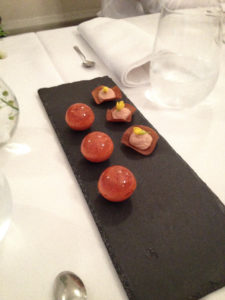
Amuse-bouches, Restaurant ES, Paris, France. Chef: Takayuki Honjo.
Welcome to our monthly food column, Amuse-bouches.
So what’s an amuse-bouche?
It’s a small dish, just a mouthful or two, served gratis at the very beginning of the meal, generally in a restaurant of some gastronomic pretension. While tiny, the amuse-bouche is designed to be tasty, eye pleasing, often playful, even whimsical, and at times provocative.
Formed from the French, it means “something to amuse your mouth.” The expression “amuse-gueule” appeared first, however, in 1946 (gueule is a familiar, somewhat vulgar word for mouth, like “trap” in the U.S. or “gob” in the U.K.). Amuse-bouche later emerged as a more polite alternative, and became the preferred term in restaurants, as well as in the English-speaking world.
At their best, amuse-bouches share something with the aphorism, the bonsai, the cameo, or other miniature forms that also pack lots of wonder into a little space.
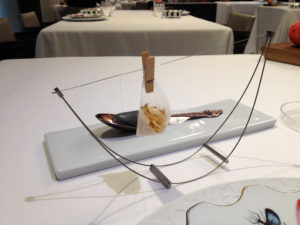
Shrimp in a bag and Stone of Manchego. Ramon Freixa Restaurant, Madrid, Spain. Chef: Ramon Freixa.
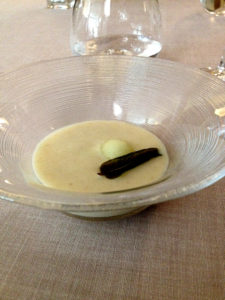
Melon soup with basil. Abantal, Seville, Spain. Chef: Julio Fernández Quintero.
Unlike tapas, dim sum, and other small plates however, you don’t order amuse-bouches. Typically, at a given meal, all customers in a restaurant receive the same one, with the choice of dish not the diner’s but rather the chef’’s prerogative. As such, the amuse-bouche can be a kind of culinary trial balloon, what Melissa Clark calls “a testing ground, a safe place to try out a risky concept, tweak it to perfection and gauge reactions.”
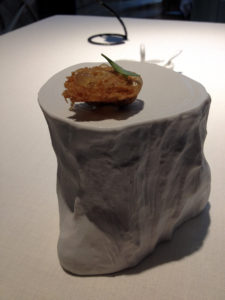
Sea anemone in tempura. Restaurant Lasarte, Barcelona. Chef: Paolo Casagrande.
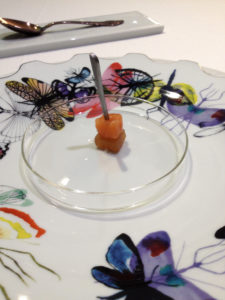
Salmon and Apple in a dome of smoke. Restaurant Ramon Freixa, Madrid, Spain. Chef: Ramon Freixa.
A prelude to the meal ahead, a pocket-sized showpiece, a site of delight and experimentation, the amuse-bouche offers insights into the chef’s culinary philosophy. As Jean-Georges Vongerichten has said (of Rick Tramonto’s Amuse-Bouche: Little Bites of Delight before the Meal Begins), “The amuse-bouche is the best way for a great chef to express his or her big ideas in small bites.”
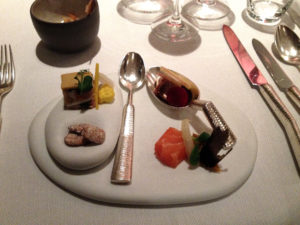
Amuse-bouches, De Karmeliet, Bruges, Belgium. Chef: Geert Van Hecke.
It is our hope that, like their namesake, our brief Amuse-bouches blog posts will entertain, surprise, and challenge you. We look forward to trying out new ideas that expand our own vision of cuisine, gastronomy, culinary culture, and food history, and whet your appetite for further exploration and reflection. Along the way, we also welcome your thoughts, comments, and suggestions.
Happy reading, and bon appétit!
